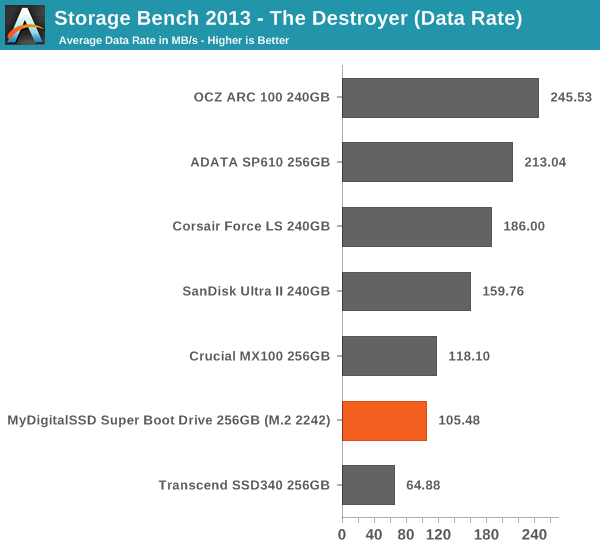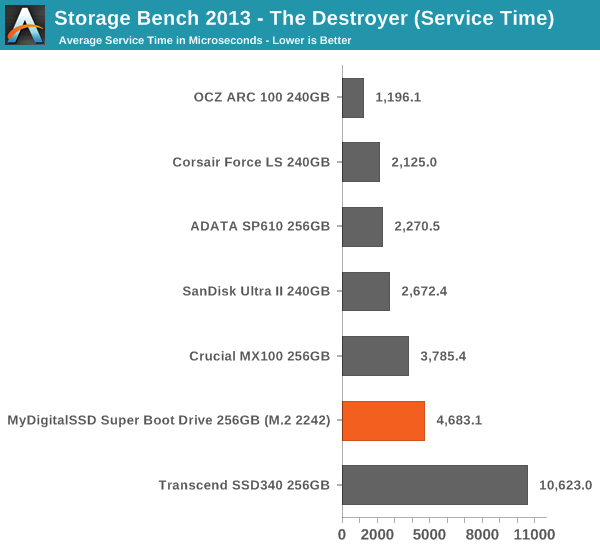Upgrading the SSD in Chromebook & MyDigitalSSD Super Boot Drive M.2 2242 SSD Review
by Kristian Vättö on October 21, 2014 8:00 AM ESTAnandTech Storage Bench 2013
Our Storage Bench 2013 focuses on worst-case multitasking and IO consistency. Similar to our earlier Storage Benches, the test is still application trace based – we record all IO requests made to a test system and play them back on the drive we are testing and run statistical analysis on the drive's responses. There are 49.8 million IO operations in total with 1583.0GB of reads and 875.6GB of writes. I'm not including the full description of the test for better readability, so make sure to read our Storage Bench 2013 introduction for the full details.
| AnandTech Storage Bench 2013 - The Destroyer | ||
| Workload | Description | Applications Used |
| Photo Sync/Editing | Import images, edit, export | Adobe Photoshop CS6, Adobe Lightroom 4, Dropbox |
| Gaming | Download/install games, play games | Steam, Deus Ex, Skyrim, StarCraft 2, BioShock Infinite |
| Virtualization | Run/manage VM, use general apps inside VM | VirtualBox |
| General Productivity | Browse the web, manage local email, copy files, encrypt/decrypt files, backup system, download content, virus/malware scan | Chrome, IE10, Outlook, Windows 8, AxCrypt, uTorrent, Ad-Aware |
| Video Playback | Copy and watch movies | Windows 8 |
| Application Development | Compile projects, check out code, download code samples | Visual Studio 2012 |
We are reporting two primary metrics with the Destroyer: average data rate in MB/s and average service time in microseconds. The former gives you an idea of the throughput of the drive during the time that it was running the test workload. This can be a very good indication of overall performance. What average data rate doesn't do a good job of is taking into account response time of very bursty (read: high queue depth) IO. By reporting average service time we heavily weigh latency for queued IOs. You'll note that this is a metric we have been reporting in our enterprise benchmarks for a while now. With the client tests maturing, the time was right for a little convergence.

The Super Boot Drive actually does surprisingly well in our 2013 suite given that it is an M.2 2242 design while the other SSDs in the comparison are 2.5". The M.2 2242 form factor does not allow for a separate DRAM cache and limits the drive to just two channels, leaving half the channels unpopulated and thus reducing maximum performance.











67 Comments
View All Comments
hojnikb - Tuesday, October 21, 2014 - link
Given the space constraints of the 2242, wouldn't make more sense to go with something like sandforce ?This is already designed with dramless in mind, so it would perform better. And at this point, these old controllers must be dirt cheap.
Also one more thing. Given how many cheap laptops use eMMC instead of real ssds, would it be possible to test that aswell ? As i'm aware, eMMC solutions are usually not that fast, but i do wonder how slow they really are.
III-V - Thursday, October 23, 2014 - link
eMMC 5.0 should be very fast, and should be surfacing in devices this year.noelbonner - Tuesday, November 11, 2014 - link
I'd go for one of the top laptops on the market instead (like the rankings at http://tinyurl.com/msegfz9 for example).duploxxx - Tuesday, October 21, 2014 - link
Anandtech quote:While the whole netbook boom kind of died with the introduction of tablets, Chromebooks have been gaining more and more traction recently. The original Windows netbooks failed to provide a smooth user experience due to the lack of operating system optimization, and Windows was simply way too heavy to be run with such limited resources
requires a BIG correction, AMD Brazos was and still is more then fine to run these netbook designs, a 7.2k or better SSD HD gives a very good daily usage of that device. It are the horrible ATOM all over the world thx to Intel and OEM designs that screwed the netbook usecases......
just like first generation ATOM for tablet is useless and made th windows tablet flop.
lilmoe - Tuesday, October 21, 2014 - link
Exactly. Hardware played a larger role in the failure of netbooks. It was simply too slow, and low power processors weren't "there" yet.Microsoft should make a huge comeback with Windows 10 in netbook form factor. Interesting will be the price and capabilities of these devices. Good performing $150-$250 Windows 10 netbooks will eat Chromebooks' lunch and make it seem they never really existed.
titaniumalloy - Tuesday, October 21, 2014 - link
I think the biggest problem is that they had stupid slow 320GB HDD. If they had used 16GB SSD, the machines would have been good. Of course, SSD were pricey 4 years ago. I believe if Microsoft come back into the netbook arena, they would perform well. Microsoft is usually way to ahead of its time or too far behind.hojnikb - Tuesday, October 21, 2014 - link
Dont forget. Very first netbooks were fitted with ssds (very small ones though).andrewaggb - Tuesday, October 21, 2014 - link
I owned 2 netbooks, one with an atom processor and a 1024x600 res screen, one with an amd c50 and 1280x720 screen.I hated them both. The keyboards were small and cramped, the screen resolution on both needed to be 768 minimum height. The hard disks were painfully slow, it took forever to get anything loaded. The amd c50 cpu was awful. It was cpu bound by all sorts of things and not nearly enough applications were gpu accelerated.
Personally, I think the 11-13" laptop range is a much better size, with at least a 1366x768 resolution and an ssd. We have those today, but not for $200.
I'd definitely rather have windows than a chromebook, but microsoft needs to get their windows updates streamlined and smaller...
jabber - Wednesday, October 22, 2014 - link
I've tried some of the new ultra cheap Windows 8.1 laptops with AMD E1 CPUs etc. and they are terrible. The CPU is so underpowered it runs at 100% the whole time. Poor HDD performance etc. Miserable experience. The problem is these are the new cheap laptops folks are buying. Makes you really appreciate a lowly Athlon or Celeron CPU, at least they worked. In comparison a Chromebook works far better for the average Joe.abianand - Thursday, October 23, 2014 - link
Let us hope the laptop manufacturers stop pairing Windows 8.1 only with slow CPUs.Richland and Kaveri have many design wins and have many (I say many, keeping in mind I'm talking about AMD CPUs here) laptops in the US market but not in many other countries.